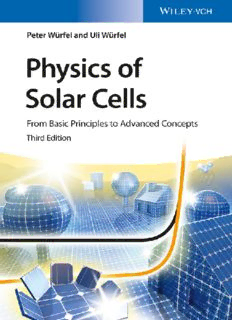Table Of ContentPeterWürfelandUliWürfel
PhysicsofSolarCells
PeterWürfelandUliWürfel
Physics of Solar Cells
FromBasicPrinciplestoAdvancedConcepts
3rdEdition
Authors AllbookspublishedbyWiley-VCHare
carefullyproduced.Nevertheless,authors,
PeterWürfel editors,andpublisherdonotwarrantthe
KarlsruheInstituteofTechnology(KIT) informationcontainedinthesebooks,
FacultytofPhysics includingthisbook,tobefreeoferrors.
Engesserstr.7 Readersareadvisedtokeepinmindthat
76131Karlsruhe statements,data,illustrations,procedural
Germany detailsorotheritemsmayinadvertently
beinaccurate.
UliWürfel
LibraryofCongressCardNo.:appliedfor
FraunhoferISE
Heidenhofstr.2
79110Freiburg BritishLibraryCataloguing-in-Publication
Germany Data
Acataloguerecordforthisbookisavail-
ablefromtheBritishLibrary.
Bibliographicinformationpublishedbythe
DeutscheNationalbibliothek
TheDeutscheNationalbibliothek
liststhispublicationintheDeutsche
Nationalbibliografie;detailed
bibliographicdataareavailableonthe
Internetat<http://dnb.d-nb.de>.
©2016Wiley-VCHVerlagGmbH&Co.
KGaA,Boschstr.12,69469Weinheim,
Germany
Allrightsreserved(includingthoseof
translationintootherlanguages).Nopart
ofthisbookmaybereproducedinany
form – byphotoprinting,
microfilm,oranyothermeans – nor
transmittedortranslatedintoamachine
languagewithoutwrittenpermission
fromthepublishers.Registerednames,
trademarks,etc.usedinthisbook,even
whennotspecificallymarkedassuch,are
nottobeconsideredunprotected
bylaw.
PrintISBN:978-3-527-41312-6
ePDFISBN:978-3-527-41311-9
ePubISBN:978-3-527-41309-6
MobiISBN:978-3-527-41310-2
CoverDesign Formgeber,Mannheim,
Germany
Typesetting SPiGlobal,Chennai,India
PrintingandBinding
Printedonacid-freepaper
V
Contents
ListofSymbols IX
Preface XI
1 ProblemsoftheEnergyEconomy 1
1.1 EnergyEconomy 1
1.2 EstimateoftheMaximumReservesofFossilEnergy 4
1.3 TheGreenhouseEffect 6
1.3.1 Combustion 6
1.3.2 TheTemperatureoftheEarth 7
1.4 Problems 9
2 Photons 11
2.1 Black-bodyRadiation 11
2.1.1 PhotonDensityn inaCavity(Planck’sLawofRadiation) 12
γ
2.1.2 EnergyCurrentThroughanAreadAintotheSolidAngledΩ 16
2.1.3 RadiationfromaSphericalSurfaceintotheSolidAngledΩ 19
2.1.4 RadiationfromaSurfaceElementintoaHemisphere
(Stefan–BoltzmannRadiationLaw) 20
2.2 Kirchhoff’sLawofRadiationforNonblackBodies 22
2.2.1 AbsorptionbySemiconductors 24
2.3 TheSolarSpectrum 24
2.3.1 AirMass 26
2.4 ConcentrationoftheSolarRadiation 28
2.4.1 TheAbbéSineCondition 29
2.4.2 GeometricalOptics 30
2.4.3 ConcentrationofRadiationUsingtheSineCondition 31
2.5 MaximumEfficiencyofSolarEnergyConversion 33
2.6 Problems 39
3 Semiconductors 41
3.1 ElectronsinSemiconductors 42
3.1.1 DistributionFunctionforElectrons 43
3.1.2 DensityofStatesD (ε )forElectrons 43
e e
VI Contents
3.1.3 DensityofElectrons 48
3.2 Holes 50
3.3 Doping 52
3.4 Quasi-FermiDistributions 57
3.4.1 FermiEnergyandElectrochemicalPotential 59
3.4.2 WorkFunction 63
3.5 GenerationofElectronsandHoles 65
3.5.1 AbsorptionofPhotons 65
3.5.2 GenerationofElectron–HolePairs 69
3.6 RecombinationofElectronsandHoles 71
3.6.1 RadiativeRecombination,EmissionofPhotons 72
3.6.2 NonradiativeRecombination 74
3.6.3 Lifetimes 85
3.7 LightEmissionbySemiconductors 87
3.7.1 TransitionRatesandAbsorptionCoefficient 88
3.8 Problems 92
4 ConversionofThermalRadiationintoChemicalEnergy 95
4.1 MaximumEfficiencyfortheProductionofChemicalEnergy 98
4.2 Shockley–QueisserLimit 103
4.3 Problems 104
5 ConversionofChemicalEnergyintoElectricalEnergy 105
5.1 TransportofElectronsandHoles 105
5.1.1 FieldCurrent 106
5.1.2 DiffusionCurrent 107
5.1.3 TotalChargeCurrent 109
5.2 SeparationofElectronsandHoles 111
5.3 DiffusionLengthofMinorityCarriers 113
5.4 DielectricRelaxation 115
5.5 AmbipolarDiffusion 116
5.6 DemberEffect 117
5.7 MathematicalDescription 120
5.8 Problems 120
6 BasicStructureofSolarCells 123
6.1 AChemicalSolarCell 123
6.2 BasicMechanismsinSolarCells 128
6.3 DyeSolarCell 131
6.4 Thepn-Junction 133
6.4.1 ElectrochemicalEquilibriumofElectronsinapn-Junctioninthe
Dark 133
6.4.2 PotentialDistributionacrossapn-Junction 134
6.4.3 Current–VoltageCharacteristicofthepn-Junction 138
6.5 pn-JunctionwithImpurityRecombination,Two-DiodeModel 143
Contents VII
6.6 Heterojunctions 147
6.7 Semiconductor–MetalContact 150
6.7.1 SchottkyContact 152
6.7.2 MISContact 153
6.8 TheRoleoftheElectricFieldinSolarCells 154
6.9 OrganicSolarCells 160
6.9.1 Excitons 160
6.9.2 StructureofOrganicSolarCells 163
6.10 LightEmittingDiodes(LED) 167
6.11 Problems 169
7 LimitationsonEnergyConversioninSolarCells 171
7.1 MaximumEfficiencyofSolarCells 171
7.2 EfficiencyofSolarCellsasaFunctionofTheirEnergyGap 174
7.3 TheOptimalSiliconSolarCell 175
7.3.1 LightTrapping 176
7.4 Thin-filmSolarCells 181
7.4.1 MinimalThicknessofaSolarCell 182
7.5 EquivalentCircuit 183
7.6 TemperatureDependenceoftheOpen-circuitVoltage 185
7.7 IntensityDependenceoftheEfficiency 186
7.8 EfficienciesoftheIndividualEnergyConversionProcesses 186
7.9 Problems 188
8 ConceptsforImprovingtheEfficiencyofSolarCells 189
8.1 TandemCells 189
8.1.1 TheElectricalInterconnectionofTandemCells 193
8.2 ConcentratorCells 194
8.3 ThermophotovoltaicEnergyConversion 196
8.4 ImpactIonization 197
8.4.1 HotElectronsfromImpactIonization 200
8.4.2 EnergyConversionwithHotElectronsandHoles 200
8.5 Two-stepExcitationinThree-levelSystems 203
8.5.1 ImpurityPhotovoltaicEffect 203
8.5.2 Up-andDown-conversionofPhotons 208
8.6 Problems 211
9 CharacterizationofSolarCells 213
9.1 SpectralResponseandQuantumEfficiency 213
9.2 Quasi-Steady-StatePhotoconductance 218
9.3 Luminescence 220
9.3.1 HomogeneousDistributionofElectronsandHoles 221
9.3.2 InhomogeneousDistributionofElectronsandHoles 222
9.3.3 Electroluminescence 223
9.3.4 Photoluminescence 224
VIII Contents
9.3.5 DiffusionLength 225
9.3.6 SeriesResistance 228
9.4 Thermography 229
9.5 Light-Beam-InducedCurrent(LBIC) 230
9.6 TheSuns-V Method 233
OC
9.7 TransientTechniques 237
9.7.1 PhotovoltageDecay 237
9.7.2 TransientAbsorption 238
9.7.3 ChargeCarrierExtraction 240
9.7.4 CELIV–ChargeExtractionbyLinearlyIncreasingVoltage 241
9.7.5 ImpedanceSpectroscopy 241
Solutions 245
Appendix 263
References 267
Index 271
Description:The new edition of this highly regarded textbook provides a detailed overview of the most important characterization techniques for solar cells and a discussion of their advantages and disadvantages. It describes in detail all aspects of solar cell function, the physics behind every single step, as

